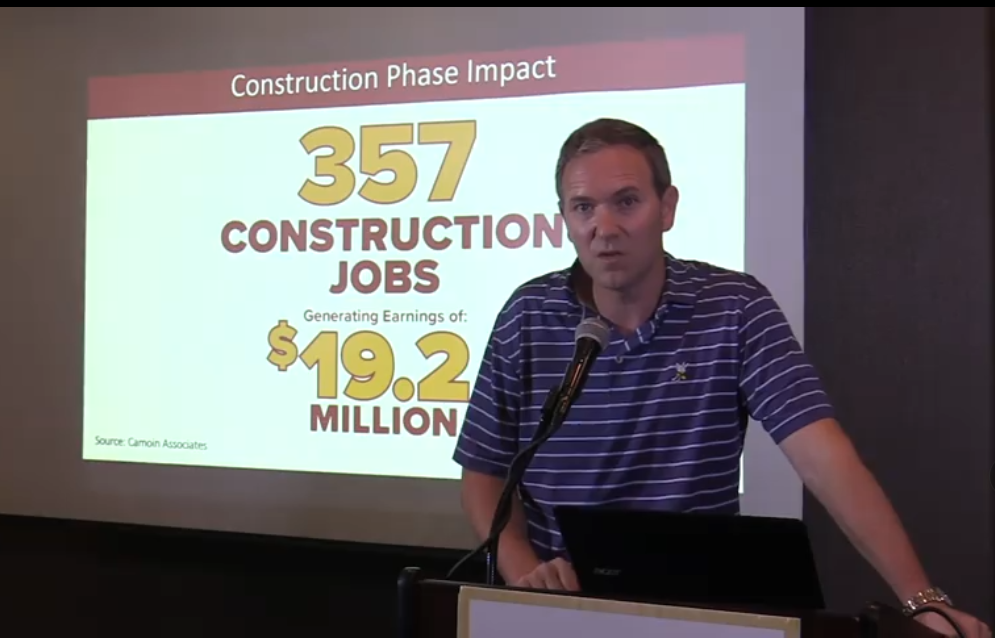Kingstonian Team Arm-Twists Outside Firm to Show “Benefit” to Community
NDC Ekes Out Slim Advantage After Local Pols and Developer Seek “Common Ground”
It’s tough to make predictions, especially about the future — Yogi Berra
April 8, 2021
Kingston, NY – A supposedly neutral third party economic development company found that the Kingstonian tax break would produce a $3.4 million “net negative public benefit” – in other words, a loss to the people of Kingston and Ulster County. But after the Kingstonian team and local government officials met with the consultants to find “common ground,” they reversed their findings and produced a report showing a slim $256,000 public benefit.
The first cost/benefit analysis by The National Development Council (NDC), dated October 16, 2020, was never made public, but it was leaked to the Vindicator and can be found here. While that report’s existence was known, what is new is the characterization of the meeting as a county-sanctioned opportunity for the developers in league with the Ulster County Industrial Development Agency to push back against unwelcome findings.
After one or more meetings brokered or organized by county officials, NDC produced a new report finding a net benefit to the community of about $256,000. This second, more favorable report apparently was finalized by Monday, Oct. 19 but was held for release until Friday, Oct. 23 after 5 pm, a choice of timing understood to avoid public scrutiny. It is on the county website, accompanied by the statement from Ulster County Executive Pat Ryan announcing, without explanation, the delayed release.
“When the county got involved in using an independent third party administrator we sat at the table with them. And my only concern at that time was look, let’s sit down and find some common ground. And I think we did, and, you know, [Ulster County Director of Economic Development] Tim Weidemann was there and other people and something was crafted at that point that everybody could live with,” IDA Chair Malcolm told the Ulster County Legislature’s Economic Development, Tourism, Housing, Planning & Transit Committee on March 2.
The first report may have been used as leverage to secure a slight increase in PILOT payments — about $2 million, far less than the $3.4 million “net negative” posited in the first NDC report.
Under the NYS Freedom of Information Law, the Vindicator is requesting a list of all meetings with NDC, Ulster County’s Economic Development Office and IDA members along with all emails. Given how this project has sharply divided the community, it is unclear how much pressure to pass the tax break originates in Albany.
Background: The Kingstonian is a proposed $57 million market rate multi-use housing project consisting of 143 apartments, boutique hotel, garage and retail space to be developed by Brad Jordan and Joseph Bonura and their unidentified investors, some of whom are said to be elected officials. The project is funded on the public dime to the tune of 60.15% through New York State grants and a property tax break that will deprive Kingston, Ulster County, and the Kingston School District of $30 million. The true public subsidy is much larger because the project is located in an Opportunity Zone and thus will enjoy the exemption from capital gains tax. Upon sale, the investors will pocket at least $100 million if they hold for ten years — not bad, considering their cash investment is $6 million. Fueled by false narratives and grossly overblown economic activity projections, this siphoning of wealth from public into private hands is one more reason for the people of Kingston to lose faith in city, county and state government.
Why would the county be involved?
Apart from the usual suspects — campaign contributions, promotions to Albany — there is another reason. Retail projects are disallowed under IDA statute except under certain circumstances, including that they provide goods and services that are otherwise unavailable. Mix in another vague exception that it is up to a county executive to determine whether a project is commercial in nature. It stands to reason that the county would wish to show an economic benefit. At the same meeting where Malcolm spoke, IDA CEO Rose Woodworth said the IDA was considering a policy requiring an independent third party cost benefit analysis, but that “in this case, the County Executive’s office took that on.”
The studies: In total, the developers and the county have commissioned four economic impact or cost/benefit analyses, comprising the two from NDC and one each from Camoin Associates and Rochester-based CGR. In all cases, they are closer to public relations brochures than to true economic studies. Real economists who study “incentives” – another word for tax breaks and grants — have found that predictions of job creation, growth and tax revenue generally fail to materialize. One of the problems with these predictions is that they rely on numbers provided by the person who’s signing the check.
A Vindicator piece published last year debunks the numbers in the second NDC study. That followed an even earlier Vindicator article that looked at the long-standing relationship between NDC and the developers.
One pill makes you larger…
Consider the magically mushrooming number of construction workers. On p. 15 of the application, the developers say they will hire 150 construction workers. Note that nowhere do the developers promise that all 150 workers will be employed every working day for the duration of the construction phase. On p. 2 of the Camoin report, this construction phase number morphs into 259 direct jobs and 98 indirect jobs. Then, at the August Chamber of Commerce, the developers presented a slide showing that 357 construction jobs would be created.
The other studies do not present the same information. The inability to compare apples to apples, the use of pie and bar charts lacking precise numbers, and the failure to place numbers side by side for easy comparison are intentional. If you find these studies confusing, the problem isn’t you.

Here’s another reason it’s wise to double check numbers provided by the client. The studies calculated an economic benefit from the garage, but the number of new spots available for the public is nowhere near what the studies accept as fact. The developers say 277 spaces will be available to the public, and that is the number inputted into the cost/benefit studies to find the public benefit. But there already exist 138 spaces, so any thoughtful analysis would have to subtract those pre-existing spaces, and that would leave only 139 new spaces. But anyone who’s looked at the code knows that the developers severely under-allocated the number of spots for tenants, hotel guests and the commercial renters, and it is possible no new spaces will be created at all. The developers say their tenants will not need the number of cars called for in code.
… And one pill makes you small
Aside from the construction worker game of telephone and the parking flim-flam, how accurate are Camoin’s predictions? In a 2013 Cobleskill Times-Journal story, a county fair administrator said Camoin had overestimated revenue and jobs by threefold. The problem in this story is mistaken assumptions, a common error in impact analyses. Others are bad methodologies such as exaggerated multipliers, the mathematical difficulty of predicting much beyond the first impact, and optimism bias.
The IDA remains unfazed by the discrepancies — between the first and the arm-twisted NDC studies; between the different factors measured, and between predicted outcomes and reality. Woodworth said, “At first I first I did not think that our cost benefit analysis software was good. And then I was honestly shocked after putting everything in that it was very in line with the other cost benefit analyses that were done and were a lot more expensive. And in defense of what numbers you’re using, we’re using the same numbers that every other cost benefit analysis would have used, and every other number that we would have used from any other project, Kingstonian or not. All we can do is use the information that the project gives us, and then make the best determination from that. And if they don’t meet the criteria that they’re saying they’re going to meet, then we’ll claw back.”
All we can do is use the information that the project gives us? When I receive an automated call telling me that a $900 iPhone has been charged to my Amazon account, I use the information the recording gives me and then make the best determination, which is usually to hang up on the scammer, rather than give out my credit card and try to claw back whatever I can down the road. Isn’t it time for the IDA to start doing the same? If you wait until after the project is built to find out you’ve been scammed, the community has been saddled with the loss for decades and the developers will have made off with their ill-gotten gains.
The Vindicator’s podcast page contains links to interviews with several economists who debunk economic forecasts.
-0-
